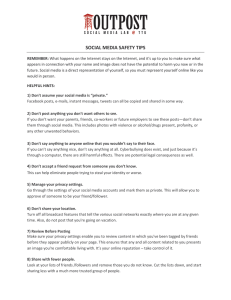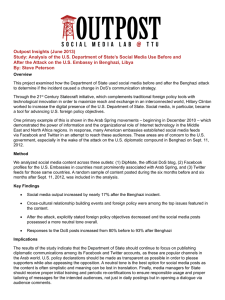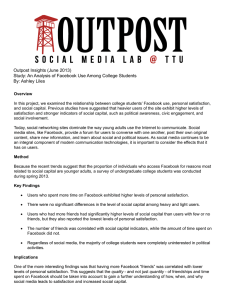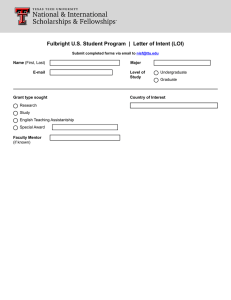Reaching Audiences: Exploring Opportunities in Hispanic Media & Market Research
advertisement
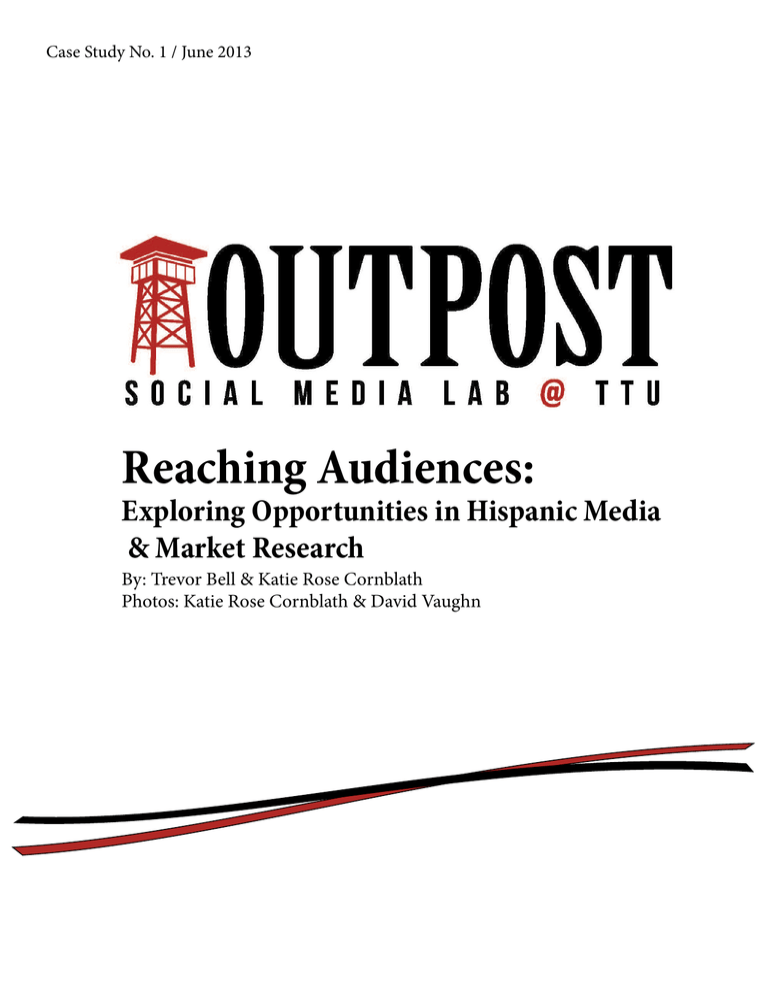
Case Study No. 1 / June 2013 Reaching Audiences: Exploring Opportunities in Hispanic Media & Market Research By: Trevor Bell & Katie Rose Cornblath Photos: Katie Rose Cornblath & David Vaughn OVERVIEW For its first outing operating a social media command center, the Outpost Social Media Lab @ TTU – located in room 251 of the College of Media & Communication – monitored social media conversations for the Reaching Audiences conference on March 4-5, 2013. The conference was hosted by the Institute for Hispanic and International Communication (IHIC) and featured experts in market research and Hispanic-oriented media who discussed trends and shifting demographics in the media industry. These industry experts not only shared their insights with undergraduate and graduate students in the college, but also worked closely with college faculty and staff to identify opportunities for collaboration between industry professionals and academics. Throughout the two-day event, student volunteers at the Outpost engaged with panelists, professionals, undergraduate students, graduate students and faculty members that participated in Reaching Audiences discussion sessions and panels. All participants were encouraged to join the conversation via social media – primarily Twitter – through the use of the hashtag #ReachingAudiences. Over the course of the event, roughly 1,200 social media posts mentioned the event, with 862 tweets incorporating the #ReachingAudiences hashtag. The use of social media engagement and monitoring software such as Radian 6 showcases a live-feed of social media interactions and creates graphs that can measure content. STUDENT ENGAGEMENT The Outpost’s social media command center was operated by a group of student volunteers consisting of four professional master’s degree students and 13 undergraduate students. Additionally, faculty members encouraged their students to participate in the event and to observe the command center in action. For instance, Dr. Todd Chambers asked students from his Contemporary Issues in Communications Technology graduate course to observe the Outpost’s operations and live-tweet from the events. Student organizations such as the HUB, the college multiplatform news outlet, and RaiderComm, the student-run public relations firm, also participated in the event both by generating content and by volunteering in the command center. Volunteers and event participants were asked to either monitor social media content using software such as Radian6 and Hootsuite or were asked to attend the panel discussions and live-tweet the event. Content was then shared on the College’s website via the creation of a Storify, through a HootFeed, and through the IHIC’s Twitter feed and Facebook page. The Reaching Audiences conference allowed everyone involved with the Outpost to learn about and work with emerging and relevant social media monitoring and engagement tools. By having an innovative social media command center like the Outpost, students – both 1 College of Media & Communication student using the software to monitor content and engage with participants during the Reaching Audience Conference. undergraduate and graduate – who are involved with these efforts were provided with the ability to distinguish themselves in a competitive communications field. After the event, several undergraduate and graduate students were asked to express their opinions regarding their participation in the command center. David Peveto, a senior public relations major and director of the student public relations firm, said: “Getting the experience of using the software that integrated media companies and public relations firms in the ‘real-world’ utilize gives a significant advantage to anyone involved with our program. The number of applications for the lab alone or in concert with the many student organizations and classes at Tech are numerous. I think this will help positively distinguish graduates of the College of Media & Communication in a competitive job market.” Through the use of social media software such as Radian6, the Outpost Social Media Lab @ TTU was able to monitor content relating to the conference and engage with those individuals tweeting about the event. These sentiments were echoed by graduate students who volunteered in the command center. Lindsey Viotto, a student in the professional master’s degree program, said: “Having the opportunity to learn about social media software that is prominent in the industry right now was really exciting and beneficial for enhancing my skills to make myself more marketable in the future. The lab let us learn what it would be like to be in a professional setting where you work with a team to curate and monitor conversations happening in real-time.” SOCIAL MEDIA INTEGRATION Integrating social media into the event had several benefits for the event, the college, and the IHIC. First, the command center volunteers were able to monitor conversations about the event across the social web to track mentions of the even and look for engagement opportunities. Second, using social media to cover the conference and then repackaging that content via a Storify feed allowed the conversations surrounding the event (both on and offline) to be amplified beyond those participants who were physically attending the event. Third, social media engagement helped to drive traffic to the IHIC’s and the CoMC’s social media profiles and to the college website. From there, audience members and other interested parties could find additional information about the event, faculty, programs, etc. Dr. Kent Wilkinson, Regents Professor in Hispanic and International Communication, expressed his views regarding the conference and the role that social media integration played in its success: “Social media platforms are a very important part of the media mix for Hispanics, who tend to overindex on social media use. Thus it was important 2 Panelists (left to right) Bill Seitzler Robert B. Affe and Salomón Dayan discuss the trends and shifting demographics in the media industry. to incorporate a social media element in this conference focused on Hispanic media and market research. The Monday March 4 session, ‘Hispanics and Social Media,’ was very well attended--and well ‘tweeted’ too. It was very informative to hear from media professionals how traditional media are adjusting to accommodate the digital media environment. The conference sessions in classes on Tuesday morning, March 5 demonstrated the potential for social media in the classroom. Students used social media in real time to contribute valuable insight into the presentations and discussions they were experiencing. As an instructor, it was useful for me to be able to follow tweets during the class, and to go back later to read the full archive. The speaker in my class, Mr. Alberto Avendaño, was impressed with the Twitter activity and began following some students based on their contributions.” Dr. Kent Wilkinson speaks with panelists and current doctoral students about the potential synergies, challenges and mutual benefits of enhanced industryacademic collaboration. Dr. Erik Bucy, Marshall and Sharleen Formby Regents Professor of Strategic Communication, also offered his opinions regarding the role of social media during the conference: “Reaching Audiences was a resounding success, in terms of audience engagement and panelist insights. The keynote speakers were fascinating and the panels ‘sizzled’ with information, insights and strategic advice. Social media definitely contributed to the conference’s success and created a lasting archive of tweets, photos and video that can be accessed for future reference. I would say Panelists (left to right) Bill Seitzler, April Alejandro, Randy the social media piece went better than expected; it Crimmins, Arturo Villar and Robert B. Affe speak to was brilliant, really.” undergraduate students about emerging trends in the Hispanic media industry. Students were encouraged to tweet their opinions and observations using the hashtag #ReachingAudiences. 3 About The Outpost Social Media Lab @ TTU The Outpost is the social media lab at Texas Tech University’s College of Media & Communication. Located in room 251, the lab features a physical command center where students can engage in live social media monitoring and engagement utilizing a variety of tools in a collaborative learning environment. In addition to live monitoring activities, the lab provides support to a number of groups within the college, such as RaiderComm, the student-run public relations firm, as well as courses, such as PR 3315: Online & Digital Public Relations. The lab produces original content providing social media insights including white papers, case studies, special projects, consulting and academic research. Lab volunteers also engage in community outreach programs such as hosting social media training and workshops. For more information, please contact the faculty lead, Dr. Trent Seltzer, at trent.seltzer@ttu.edu. Like us on Facebook: https://www.facebook.com/OutpostLab Follow us on Twitter: @TTU_Outpost Visit us on our website: www.depts.ttu.edu/comc/outpost/
